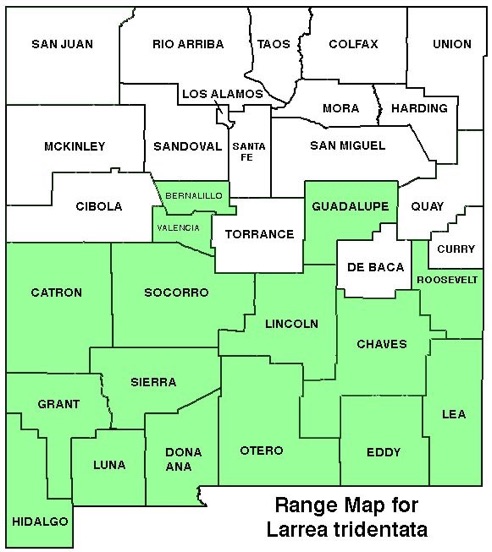WILDFLOWERS OF NEW MEXICO

Densely branching with woody, leafy stems, and averaging 3-6 feet tall and wide (12 feet in aged specimens), this desert icon is one of the dominant shrubs in the Chihuahua, Mojave, and Sonora deserts. Though each desert population has a separate genotype, they all are considered the same species. Larrea is an ecological keystone plant that supports numerous mammal, reptile, bird, and insect species, and is superbly adapted to thriving in hostile, arid habitats. Note the small, waxy, dark-green leaves, yellow flowers, and fuzzy seed capsules. The name “creosote” comes from the delightful aroma the plant emits after a desert storm.
FLOWER: April–September, year around after rains. Solitary flowers 1 1/4 inch diameter (3 cm) from leaf axils have 5 narrow, yellow petals, each 1/4–1/2 inch long (7–11 mm); after pollination, the petals tend to twist appearing propeller-like; fruit is a fuzzy white capsule with 5 nutlets.
LEAVES: Opposite, evergreen, crowded on branch ends. Blades have 2 unequal elliptical leaflets fused at the base; leaflets average 3/8–3/4 inch long (10–18 mm); surfaces dark-green, lustrous, resinous, highly aromatic after rains. The waxy surfaces decrease water loss through transpiration, and a complex combination of chemicals deter herbivores.
HABITAT: Arid sandy-gravelly, limestone, caliche, rocky soils of deserts, slopes, bajadas, volcanic hills, mesas; desert grasslands and scrub.
ELEVATION: 3,230–6,500 feet.
RANGE: AZ, CA, NM, NV, UT, TX; Mexico. The isolated population on the volcanic hills at the southern edge of Albuquerque along IH-40 at Isleta Pueblo is considered the most northern occurrence in the Chihuahua desert.
SIMILAR SPECIES: The shrubby form, dark-green, resinous, aromatic leaves, and desert habitat distinguish this widespread plant.
NM COUNTIES: Southern half of NM in low-elevation, desert habitats: Bernalillo, Catron, Chaves, Dona Ana, Eddy, Grant, Guadalupe, Hidalgo, Lea, Lincoln, Luna, Otero, Roosevelt, Sierra, Socorro, Valencia.
NOTES: Flora of North America reports that fossil pollen of Larrea tridentata recovered in California date back 109,000 years. In some Mojave Desert plants, root shoots spread in a circle around the parent plant and form oval clonal stands as the older, center plants die. The oldest living organism yet discovered on the planet is a clonal ring named King Clone in Lucerne Valley, California. Measuring 72 x 26 feet, it is estimated to be 11,700 years old. Historically, medicinal remedies from Larrea have been widely used for the antioxidant and antimicrobial qualities of the more than 360 resins, oils, and chemicals in its leaves.









CREOSOTE BUSH
LARREA TRIDENTATA
Caltrop Family, Zygophyllaceae
Perennial evergreen shrub


















THE CONTENTS OF THIS WEBSITE ARE COPYRIGHTED AND CANNOT BE USED
WITHOUT PERMISSION OF GEORGE OXFORD MILLER
















EMAIL ME


















Photo from the Mojave Project









The fruit is a fuzzy white seed capsule.


The evergreen leaves have 2 small leaflets fused at the base.
Resinous leaves cover the dense branches. A complex of hundreds oils and other chemical compounds inhibits herbivores, produces an intense aroma after rains, and endows the plant with a myriad of medicinal uses.









This clonal creosote bush ring in the Mojave desert is estimated to be 11,700 years old.









Creosote bush is rounded in form and usually widely spaced with few shrubby plants growing in between. In the Southwest, it is usually found in rocky, gravelly soils, not in loose sand.







